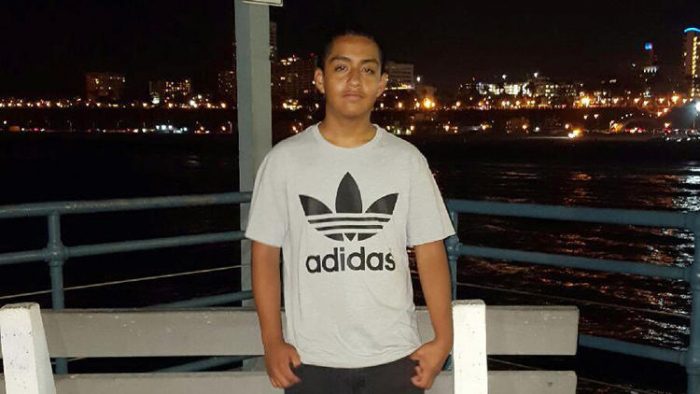

Jesse Romero (Photo provided to media from Romero Family)
While all eyes were on Milwaukee during three nights of rioting in the Sherman Park neighborhood, another officer-involved shooting that sparked protests occurred in Los Angeles.
On August 9, LAPD responded to a call of two teens who were writing graffiti and possibly engaging in narcotic activity in Boyle Heights, a neighborhood east of downtown. When officers arrived at the scene, 14-year-old Jesse Romero fled. During the pursuit, a gunshot went off and officers then shot and killed Romero. Eyewitness accounts reported that Romero had a gun, but the accounts differ based off whether he pointed it towards officers or if he threw it to the ground, accidentally discharging it. The incident sparked protests, but shortly afterward, people on social media shared images of Romero’s alleged gang affiliation, a subtle suggestion that he “deserved” it.
Whatever the case may be, it doesn’t take the “perfect” victim for marginalized communities to erupt in anger. The protests over Romero’s death, as with all police shootings, deal more with long-standing grievances in the community than the initial incident. In response to the shooting, executive director of Legacy LA Lou Calanche said, “We are asking the city of Los Angeles to prioritize positive youth development resources in our city.” This comment is indicative of how Romero’s death represented a bigger problem in the community: it served as a reminder that the incident could have been avoided if the community had resources to keep youth out of trouble.
A quick overview of Boyle Heights reveals why Romero’s death sparked outrage. According to researchers at San Diego State University and the University of South California, Boyle Heights is one of Los Angeles County’s poorest communities. It has a poverty rate of 33 percent and a median income of $33,253, which is a lower median income than the average for all of Los Angeles, which stands at $53,000. Homeownership rates stand at 11 percent. Low rates of homeownership have displaced residents, as gentrification creeps into the area. The city has yet to respond to residents’ demands for city officials to invest more in citywide youth programs to keep youth engaged in positive activities. On top of this, Romero was the second teen killed in Boyle Heights by LAPD this year.
Taking into account all these factors, the anger expressed by some residents shouldn’t come across as surprising, but Americans sometimes appear to have an ahistorical understanding of protests against police violence. Numerous urban rebellions and protests have begun even when the final evidence proved that the police had probable cause. Yet, it seems that Americans have learned little from this history or are largely unaware of it.
As long as there are inner-city and suburban communities experiencing disinvestment, concentrated poverty and inadequate employment opportunities, protests and riots over allegations of police brutality will likely continue. Elected officials who continue to ignore marginalized groups until those communities erupt in violence will always experience civil unrest in their cities. Journalists in Philadelphia noted this in 1988 after a night of violence in Hunting Park, a predominately Puerto Rican community in North Philadelphia:
What irks some community leaders is the city’s knee-jerk response to the riot. They said it confirms that government —from Washington to Harrisburg to Philadelphia— will continue to ignore the community’s long-standing problems and step in only when the violence makes headlines.
This doesn’t mean protests will happen in all poor communities, but persisted problems such as police harassment, unemployment and municipal neglect can only go on for so long before an incident like a violent police encounter lights the fuse.
As former Baltimore Police Chief Ed Norris said, police departments are the “visible arm of the government.” Grievances over municipal neglect, poverty, disinvestment and other issues will always be directed towards police since they are the state institution that poor minority communities come into contact with most frequently. Until Americans acknowledge these structural problems, they will continue to only focus on what sparked protests and riots rather than examine the roots of anger. Outrage of police killings, even if the person so-called “deserved it,” will continue to happen.
***
Originally from Allentown, Pennsylvania, Aaron G. Fountain, Jr. is a Ph.D. student in the Department of History at Indiana University-Bloomington. Twitter: @aaronfountainjr



Nice
<a href=”http://www.dokterpoker.com/”>domino qiu qiu</a><br />
I really liked your article , your article is very petrified me in the learning process and provide additional knowledge to me , maybe I can learn more from you , I will wait for your next article article , thanks
http://yakuza4d.com/peraturan
http://yakuza4d.com
http://yakuza4d.com/home
http://yakuza4d.com/daftar
http://yakuza4d.com/cara_main
http://yakuza4d.com/hasil
http://yakuza4d.com/buku_mimpi
http://beritamedannews.blogspot.com
http://www.cintaberita.com
http://yakuza4d2.com
http://yakuza4d2.com/promo
http://yakuza4d2.com/daftar
http://yakuza4d2.com/cara_main
http://yakuza4d2.com/hasil
http://yakuza4d2.com/buku_mimpi